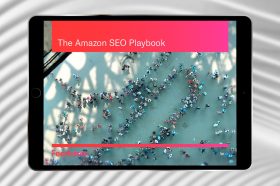Resources - Blog
How to Increase Product Visibility on Amazon

Stay on top of the latest e-commerce and marketplace trends.
If there is one thing to remember about navigating Amazon and their SEO, it’s that their customer-centric strategy applies to all facets of their business — prioritizing catering to their customers across its e-commerce marketplace. Although sellers can take different measures to improve their product discoverability and visibility, it is critical to keep metrics that impact the customer experience front of mind at all times.
Getting your listings on Amazon is phase one, but following through and making your items visible to buyers and getting to know their buying process is where the heavy lifting comes in. We’ve rounded up four proven strategies to help the items in your catalog, particularly your top sellers, get the exposure they deserve.
Have a Strong Pricing Strategy
To begin, price is not the only factor that Amazon’s algorithm analyzes when dictating a Buy Box winner — however, many experts argue that it is the most important one. There are other attributes (these vary in importance) such as fulfillment method, item condition, shipping time, seller feedback count, seller feedback score, order defect rate, late shipment rate, on-time delivery, cancellation rate, and refund rate.
It is in fact possible to beat Amazon to the Buy Box and it can be accomplished by aiming to perfect at least one of these areas: better availability, faster shipping time, and a better/lower price. It is also common that Buy Box winners win the space with higher prices than their competitors — they simply maintain better performance metrics when it comes to availability or shipping. Mastering and maintaining Buy Box share is crucial to product visibility, as the Buy Box winner will go on to make more sales than any other seller for that product (unless of course there are multiple high-ranked sellers. Then, they will rotate in the Buy Box, each gaining their share of product sales.
In our eBook entitled “The Latest in E-Commerce Consumer Behavior Trends,” it was revealed that price remains the most significant factor of influence for Amazon shoppers. 65% of Amazon customers ranked lower price as the main factor they consider when deciding to purchase on Amazon. With the constantly changing pricing landscape of the Amazon marketplace, working with a partner to help establish a pricing strategy and automate price changes in real-time according to the market can help you stay competitive and increase profitability.
Optimize Visibility Through Search
Over 45% of Prime members purchase on Amazon at least once a week, about half of the number who browse weekly. With non-Prime members, the difference is even more pronounced, with 13% purchasing on Amazon at least once a week, just under a quarter of those who report weekly browsing. These numbers are up tremendously versus last year, revealing the increased tendency for buyers to use Amazon more during browsing and the rise of more frequent buying on the marketplace.
Customers rely on Amazon’s algorithm to find the products that these customers are looking for via a product search, so it is important for sellers to take an SEO approach to keywords and optimize them whenever possible. When it comes to keywords, there should be an emphasis on tailoring them for visibility, relevance, and conversion.
The title of your product listing is what will catch the attention of a prospective buyer once they touch down on your product page and should be no more than 50 characters. It’s also crucial that it contains information such as brand, product line, color, size, material or key feature, and packaging or quantity and order them in a fashion that places the most relevant keywords first. Not only does this help the customer easily understand what you are selling, but Amazon’s algorithm gives higher relevance to keywords that appear earlier in the title, a win-win.
However, it’s important not to overdo it on the keywords. If the title feels unnatural when reading it, a customer might stray away from your product listing because it’s confusing, doesn’t make sense, or simply is only focused on keyword-stuffing instead of appealing to the customer in a clear and concise title. Additionally, including listing bullets are another way to optimize your product listing page, in order to aid relevance and conversion. Well-written product descriptions should tell a story and relay a sense of urgency via a strong call to action.
Next, having multiple, high-resolution product images are positively correlated with rank in the search results. Customers want to be able to see the product from multiple angles, be able to zoom in, and see it in use or worn depending on what it is. Sellers should use a white background with clear lighting, make sure that the main image fills at least 80% of the frame, highlights product benefits and uses, clearly shows your brand if you are selling private label items, and is at least 1000×1000 pixels for zoom capability.
Get Positive Customer Reviews and Seller Feedback
Customer reviews matter for conversions, which in turn impact sales history. Sales history is a driving factor of search rank. When it comes to improving your CTR (click-through rate) and conversion rate, customer reviews and seller feedback are an integral part of the puzzle.
Products with good ratings (four stars or higher) make it to the top of Amazon’s search results more frequently, so it’s important to check in on your reviews in order to act upon any negative ones as soon as possible and demonstrate how your store prioritizes customer satisfaction. Keep the line of communication open with your customers so they know that you are approachable and fast-acting to turn any negative interaction around. These characteristics will boost your credibility to your customer base.
You can encourage customer reviews by reaching out to consistent and recent shoppers — the most recent reviews are the most important ones. You can politely ask them to post a review about the product, such as what they liked about it and if they would purchase it again. Reviews are simply a review of the product, not the seller or the purchasing experience.
However, seller feedback is a variable that impacts the seller’s ability to win the Buy Box. With Buy Box share, comes increased marketplace visibility and conversions. Two of the most difficult metrics for sellers to boost are Feedback Score and Feedback Count, both of which rely entirely on the buyer to act on.
Sellers can encourage buyers to leave feedback in a number of ways. They can add a cute and quirky feedback request message to the packaging slip in the order. They can also contact the buyer directly, via the Contact Buyer link in the Manage Orders section of Seller Central. Alternatively, feedback tools are available to automatically send reminders to the buyer once a sale is complete.
Improve Visibility With Product Ads
Many advertising opportunities exist on the Amazon marketplace for sellers to increase their exposure and product visibility.
- Sponsored Products – PPC campaigns that are keyword targeted and appear within search results. Sellers only pay for the ads that shoppers click on. Your products will only appear in the search results to shoppers who are looking for what you have to offer.
- Sponsored Brands – Formerly known as Headline Search Ads, these ads are PPC campaigns that are keyword targeted and appear above search results. The sweet spot positioning of these ads above the search results helps drive traffic to product listings. The ads require three or more products that are variations of each other.
- Display Ads – These appear on product detail pages. They are geared toward shoppers’ interests (those who are actively viewing specific products) and are product targeted.
To increase product ad visibility and ensure your ads appear highly for competitive searches, be sure to leverage keyword match type and negative keywords to fine-tune which customer search queries your ads are eligible to show against. Your Sponsored Product and Sponsored Brands campaigns, for example, can have a variety of keywords on all three match types, with bids based on anticipated traffic. High-traffic, high-impact keywords should have higher bids, while broader keywords should be assigned lower bids.
With all keywords involved in your Amazon product detail pages and ad campaign placements, there should be an ongoing emphasis on tailoring them for visibility, relevance, and conversion. Additionally, negative keyword harvesting can help reduce wasted spend from irrelevant clicks and can decrease advertising costs without decreasing visibility and conversion for potential customers.
Final Thoughts
Sellers are often pulled in multiple directions when trying to decide which strategy will increase their product visibility on Amazon, while simultaneously balancing the operational side of their business including tasks such as maintaining the proper inventory position, optimizing shipping and fulfillment, and measuring performance.
When incorporating any of these strategies into your business model (which will likely happen at different times based on how long you’ve been selling on Amazon and what stage of the product lifecycle your items are in), it will be crucial to put the customer first and hone in on shopper intent in order to drive the most clicks and conversions.
Learn what Feedvisor can do for your business.
When you partner with Feedvisor, you automatically receive access to our true, AI-driven technology and hands-on team of e-commerce experts. Contact one of our team members today to learn more about our end-to-end solution for brands and large sellers on Amazon, Walmart, and e-marketplaces.



